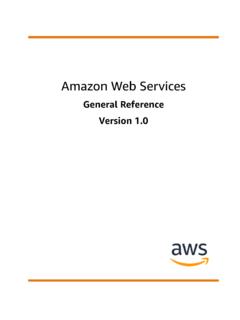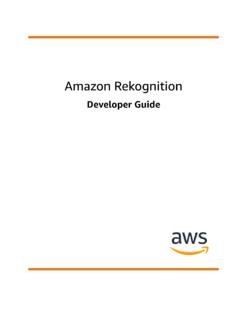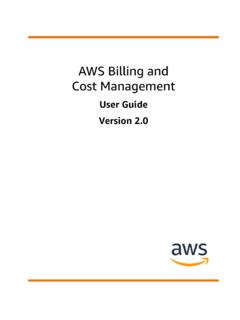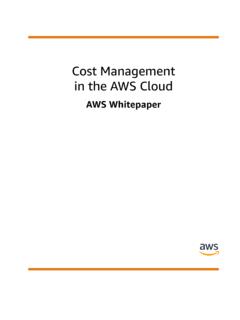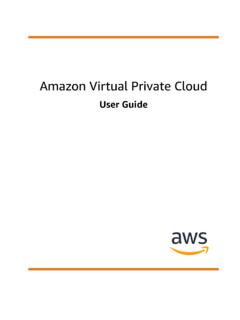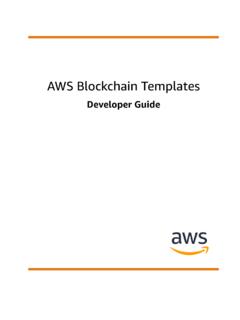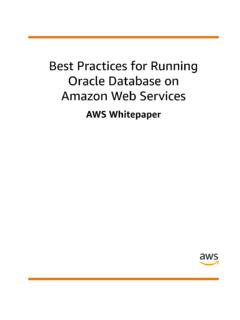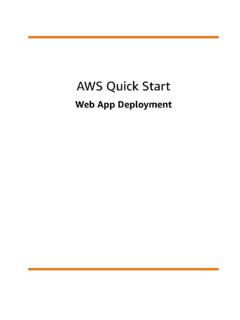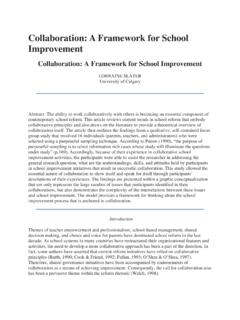Transcription of AWS Well-Architected Framework
1 Reliability PillarAWS Well-Architected FrameworkReliability Pillar AWS Well-Architected FrameworkReliability Pillar: AWS Well-Architected FrameworkCopyright Amazon Web Services, Inc. and/or its affiliates. All rights 's trademarks and trade dress may not be used in connection with any product or service that is notAmazon's, in any manner that is likely to cause confusion among customers, or in any manner that disparages ordiscredits Amazon. All other trademarks not owned by Amazon are the property of their respective owners, who mayor may not be affiliated with, connected to, or sponsored by Pillar AWS Well-Architected FrameworkTable of ContentsAbstract and Introduction.
2 1 Abstract .. 1 Introduction .. 1 Reliability .. 2 Design 2 Resiliency, and the Components of Reliability .. 3 Availability .. 3 Disaster Recovery (DR) Objectives .. 6 Understanding Availability Needs .. 7 Foundations .. 8 Manage Service Quotas and Constraints .. 8 Resources .. 9 Plan your Network Topology .. 9 Resources .. 13 Workload Architecture .. 14 Design Your Workload Service Architecture .. 14 Resources .. 16 Design Interactions in a Distributed System to Prevent Failures .. 16 Resources .. 18 Design Interactions in a Distributed System to Mitigate or Withstand Failures.
3 19 Resources .. 23 Change 24 Monitor Workload Resources .. 24 Resources .. 27 Design your Workload to Adapt to Changes in Demand .. 27 Resources .. 28 Implement 29 Additional deployment patterns to minimize risk: .. 31 Operational Readiness Reviews (ORRs) .. 31 Resources .. 32 Failure Management .. 33 Back up 33 Resources .. 34 Use Fault Isolation to Protect Your Workload .. 35 Resources .. 40 Design your Workload to Withstand Component Failures .. 40 Resources .. 43 Test Reliability .. 44 Resources .. 47 Plan for Disaster Recovery (DR) .. 47 Resources .. 49 Example Implementations for Availability Goals.
4 51 Dependency Selection .. 51 Single-Region Scenarios .. 512 9s (99%) Scenario .. 523 9s ( ) Scenario .. 534 9s ( ) Scenario .. 55 Multi-Region Scenarios .. 573 9s ( ) with a Recovery Time between 5 and 30 Minutes .. 575 9s ( ) or Higher Scenario with a Recovery Time under 1 minute .. 60 Resources .. 62 Labs .. 63iiiReliability Pillar AWS Well-Architected FrameworkExternal Links .. 63 Books .. 65 Further Reading .. 66 Document Revisions .. 67 Appendix A: Designed-For Availability for Select AWS Services .. 70ivReliability Pillar AWS Well-Architected FrameworkAbstractReliability Pillar - AWS Well-Architected FrameworkPublication date: July 2020 (Document Revisions (p.))
5 67))AbstractThe focus of this paper is the reliability pillar of the AWS Well-Architected Framework . It providesguidance to help customers apply best practices in the design, delivery, and maintenance of AmazonWeb Services (AWS) AWS Well-Architected Framework helps you understand the pros and cons of decisions you makewhile building workloads on AWS. By using the Framework you will learn architectural best practicesfor designing and operating reliable, secure, efficient, and cost-effective workloads in the cloud. Itprovides a way to consistently measure your architectures against best practices and identify areas forimprovement.
6 We believe that having Well-Architected workload greatly increases the likelihood ofbusiness AWS Well-Architected Framework is based on six pillars: Operational Excellence Security Reliability Performance Efficiency Cost Optimization SustainabilityThis paper focuses on the reliability pillar and how to apply it to your solutions. Achieving reliabilitycan be challenging in traditional on-premises environments due to single points of failure, lack ofautomation, and lack of elasticity. By adopting the practices in this paper you will build architecturesthat have strong foundations, resilient architecture, consistent change management, and proven failurerecovery paper is intended for those in technology roles, such as chief technology officers (CTOs), architects,developers, and operations team members.
7 After reading this paper, you will understand AWS bestpractices and strategies to use when designing cloud architectures for reliability. This paper includeshigh-level implementation details and architectural patterns, as well as references to Pillar AWS Well-Architected FrameworkDesign PrinciplesReliabilityThe reliability pillar encompasses the ability of a workload to perform its intended function correctly andconsistently when it s expected to. This includes the ability to operate and test the workload through itstotal lifecycle. This paper provides in-depth, best practice guidance for implementing reliable workloadson Design Principles (p.)
8 2) Definitions (p. 2) Understanding Availability Needs (p. 7)Design PrinciplesIn the cloud, there are a number of principles that can help you increase reliability. Keep these in mind aswe discuss best practices: Automatically recover from failure: By monitoring a workload for key performance indicators(KPIs), you can trigger automation when a threshold is breached. These KPIs should be a measure ofbusiness value, not of the technical aspects of the operation of the service. This allows for automaticnotification and tracking of failures, and for automated recovery processes that work around or repairthe failure.
9 With more sophisticated automation, it s possible to anticipate and remediate failuresbefore they occur. Test recovery procedures: In an on-premises environment, testing is often conducted to provethat the workload works in a particular scenario. Testing is not typically used to validate recoverystrategies. In the cloud, you can test how your workload fails, and you can validate your recoveryprocedures. You can use automation to simulate different failures or to recreate scenarios that led tofailures before. This approach exposes failure pathways that you can test and fix before a real failurescenario occurs, thus reducing risk.
10 Scale horizontally to increase aggregate workload availability: Replace one large resource withmultiple small resources to reduce the impact of a single failure on the overall workload. Distributerequests across multiple, smaller resources to ensure that they don t share a common point of failure. Stop guessing capacity: A common cause of failure in on-premises workloads is resource saturation,when the demands placed on a workload exceed the capacity of that workload (this is often theobjective of denial of service attacks). In the cloud, you can monitor demand and workload utilization,and automate the addition or removal of resources to maintain the optimal level to satisfy demandwithout over- or under-provisioning.
